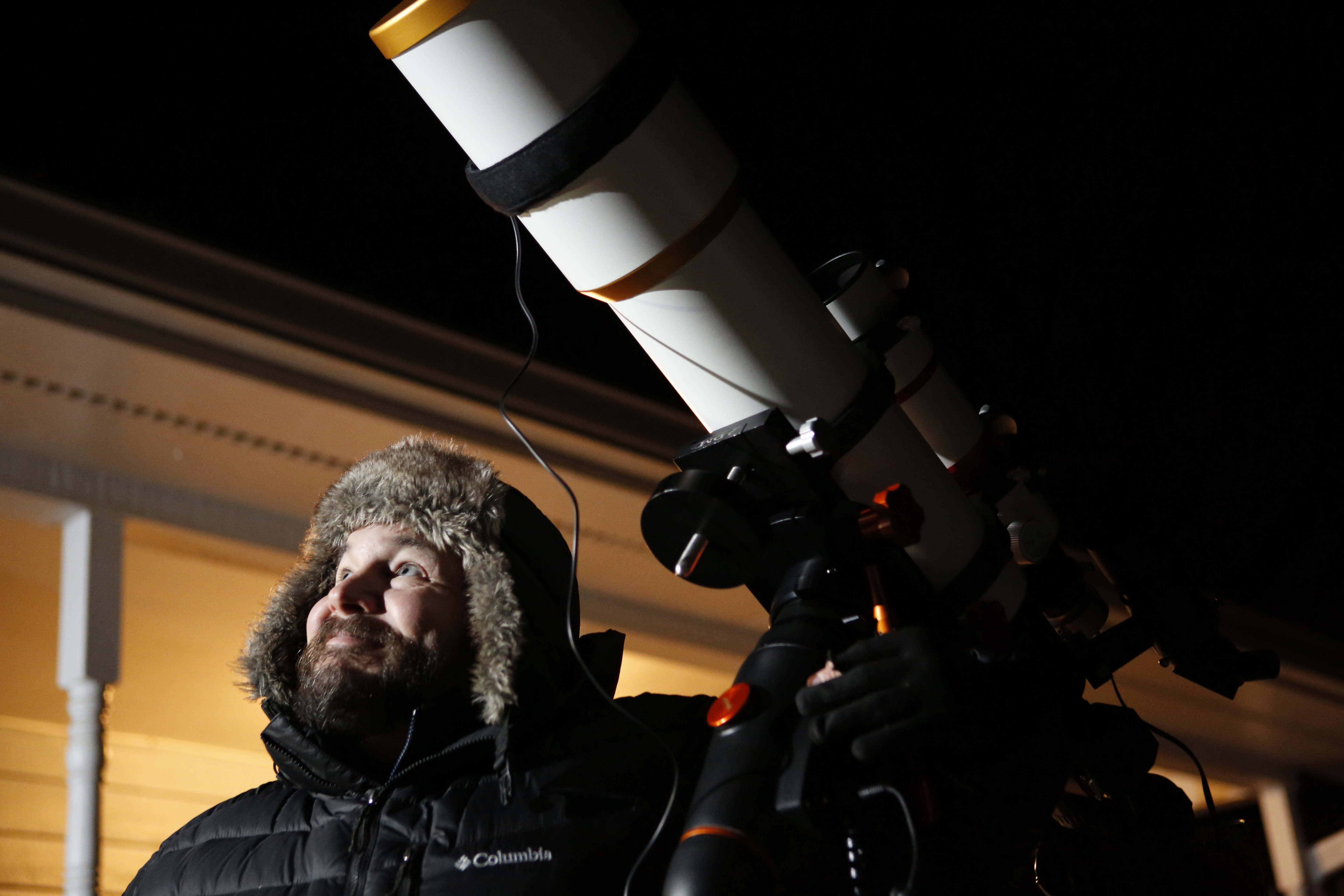GalleryView a collection of Matt Harbison's astrophotography at sceniccityphotography.com/astrophotography. Watch a video with time-lapse imagery from his viewing locations at sceniccityphotography.com/blog/2014/9/barnard-astronomical-society-year-end-footage.Tips from a proAstrophotographer Matt Harbison offers the following tips to those interested in photographing the stars:--Before buying equipment, decide what type of photography you want to do: single image, long exposure, Milky Way panoramas, star trails, planetary or deep-space objects.--Research your camera and ensure it offers proper manual modes, such as long exposure and control over ISO.--Purchase an intervalometer to time the camera shutter for taking long-exposure shots.--Use a tripod and be patient.--Research your target before getting out.--Take images on good nights with little or no moon.--Download "Star Walk" (iOS/Android) on smartphone to quickly see the night sky and find objects--Join the Barnard Astronomical Society in Chattanooga to attend monthly star parties and learn from the other amateur astronomers.--For more info, check out Harbison's multi-part amateur astrophotoraphy blog at sceniccityphotography.com/blog.
Even in a well-lit living room, convincing a toddler to sit still long enough to snap a blur-free photo can involve more cajoling and pleading than a hostage negotiation.
So imagine how much more difficult the task becomes when it's nighttime, the camera must remain in focus for longer than the runtime of the average sitcom and the subject is ceaselessly drifting trillions of miles away.
Even if they're in a cooperative mood, stars can't just "hold still for a second."
"The precision needed to accurately capture these things -- and not just capture them but correctly capture them -- is mind-numbing," says Matt Harbison.
A youth minister at St. Peter's Episcopal Church for the last 15 years, Harbison, 38, began seriously pursuing astrophotography about four years ago, using a telescopic camera mount he and his father-in-law built with plans downloaded from the Internet. Since then, he has invested thousands of dollars in a pair of powerful refracting telescopes and sturdy, motorized mounts that, once properly aligned, can keep astronomically distant objects in razor-sharp focus even as they arc across the heavens.
Dimming the lights
In most of the area surrounding Harbison's home in Red Bank, light pollution leaking from downtown Chattanooga reduces the star field from a spray of light to a handful of lonely pinpricks. Situated atop a steep ridge, however, the skies above his ranch-style home are less affected by the intrusive glow, and the stars are both more numerous and prominent.
To the side of the house, his telescopes sit attached to a laptop in an area where every light source has been doused to create a pocket of near-total darkness. Even a window leading into a nearby storage room is covered with cardboard to prevent any rebellious rays from reaching the lens.
Even with these measures in place, however, imaging in the suburbs is always a crapshoot, he says, the red bulb of his head lamp casting a lurid -- but night vision-preserving -- glow as he adjusts his equipment.
"When you're taking pictures of deep-sky objects, there is a lot that can go wrong, so patience is necessary," he explains. "You're not going to go out the first night and get the best image in the world. On the first night, if you get an image at all, you had a good night."
Emerging from a door leading off the pitch-black living room, Harbison's wife, Katie, informs him that temperatures are hovering in the low 20s. Wearing four pairs of pants, a hunter's cap and a black down jacket with a duct tape-patched right shoulder, he barely reacts to the update.
"Oh really?" he replies disinterestedly while continuing to make adjustments.
That he's willing to endure such conditions to image comes as no surprise, she says.
"Nothing about freezing cold is fun to me," she laughs. "It's his hobby and he loves it. I get to see the final product, but I'm not a part of the long hours in the cold at night."
Looking back in time
Astrophotography is an inherently difficult pursuit, and hobbyists say there's an appeal in the challenge. Trying to capture and preserve some small, elegant sliver of the cosmic mysteries in his eyepiece is an enticing brass ring to chase, Harbison says, even when conditions are inhospitable.
That goal is what compels him and other hobbyists to drive for hours in search of sites devoid of light pollution, often in winter, when the freezing cold goes hand-in-hand with the best viewing conditions. And once they arrive, the thought of that dream image -- and a steady supply of chemical hand warmers -- helps see them through the hours while the motorized drives on their telescopes keep their cameras precisely trained on the stars pinwheeling overhead.
However, producing photos to rival those seen in the glossy pages of textbooks and magazines isn't a matter of simply pressing a button and waiting. It's a process on a scale that's more geologic than digital.
Despite being titanic nuclear furnaces that have emitted blinding light for billions of years, subjects as distant as stars often are barely detectable even by powerful telescopes. Bringing them into sharp focus means exposures that stretch to Victorian durations in order to ensure the camera's sensor gleans every last photon of light that has traversed trillions of miles and millions of years to get there.
The North Star, Polaris, sits in a nook of clear sky wedged between a pair of leafless trees at the edge of Harbison's property. By precisely aligning his telescope onto this fixed point in the night sky, the computer-controlled mount of his smaller, 4-inch "research" telescope is able to locate and automatically track any entry in its extensive database of viewable objects.
With gloved fingers, Harbison types "M31" into a keypad attached to the mount. The motors engage and swivel the scope until it's pointing almost directly overhead onto what appears, with the naked eye, to be a patch of empty sky.
Harbison sets a three-minute exposure on the digital single-lens reflex camera attached to the scope. When the viewfinder illuminates, it reveals the Andromeda galaxy, an elliptical whirl of more than 200 billion stars whose light was emitted when humans discovered the use of tools 2.5 million years ago.
Although he has photographed nebulae, planets and other astronomical phenomena, Harbison says he returns time and again to galaxies, particularly Andromeda, which was the first subject he photographed.
Pursuing astrophotography, he says, is a bit like building an onion, layer by layer. Even under ideal conditions, the detail in a single photo can be lacking, so astrophotographers must return to the same galaxy or nebulae time and time again. Over time, they compile hours', days', even weeks' worth of data. By feeding this information through editing software, they can "stack" successive images atop one another, each one adding a little more color, a little more definition.
A marathon, not a sprint
Harbison's photos of Andromeda represent more than two years' worth of imaging.
"It is the object I have the most data on," he says. "There's so much detail there. An astrophotographer could photograph for a lifetime and not get all that detail."
Part of the difficulty inherent in astrophotography is that the earth's rotation and movement around the sun means objects are only visible at certain times of year. Since viewing conditions are often so fickle, Harbison says getting even 20 shootable days in a year is considered a bumper crop.
As a result, the process of achieving the desired level of detail is a marathon pursuit, he says.
"I want people to look at my images and go, 'Oh my gosh!'" Harbison says. "I have a pursuit of that, and it will take a couple of years, but I'm willing to do it. I like something that's not easy. I like a challenge."
And in a day and age when technology provides instant access to most things, Harbison says astrophotography is a welcome throwback to a time when the best things in life couldn't be hurried.
"It's nice that something can still take a while," he says. "The thought of taking a photo over the course of a year of light that's millions of light years away -- trillions of miles away -- adds a little bit of mystery back into things.
"I've found a little bit of peace in that. The further back I look into my telescope, the smaller I feel."
Contact Casey Phillips at cphillips@timesfreepress.com or 423-757-6205. Follow him on Twitter at @PhillipsCTFP.


